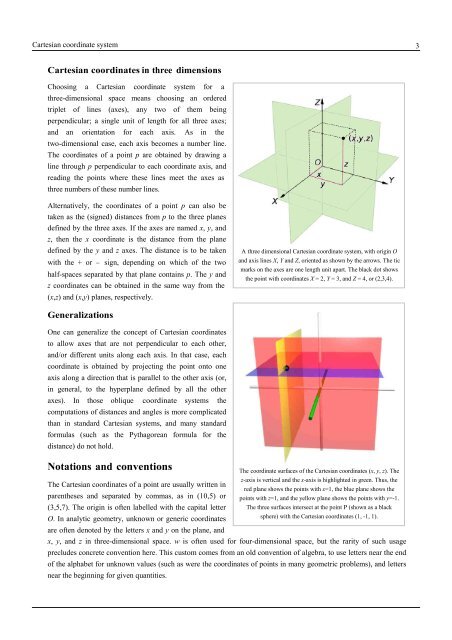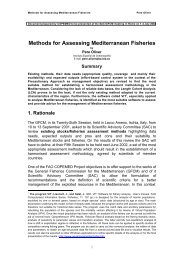Cours sur les méthodes d'évaluation acoustique ... - Fao - Copemed
Cours sur les méthodes d'évaluation acoustique ... - Fao - Copemed
Cours sur les méthodes d'évaluation acoustique ... - Fao - Copemed
You also want an ePaper? Increase the reach of your titles
YUMPU automatically turns print PDFs into web optimized ePapers that Google loves.
Cartesian coordinate system 3Cartesian coordinates in three dimensionsChoosing a Cartesian coordinate system for athree-dimensional space means choosing an orderedtriplet of lines (axes), any two of them beingperpendicular; a single unit of length for all three axes;and an orientation for each axis. As in thetwo-dimensional case, each axis becomes a number line.The coordinates of a point p are obtained by drawing aline through p perpendicular to each coordinate axis, andreading the points where these lines meet the axes asthree numbers of these number lines.Alternatively, the coordinates of a point p can also betaken as the (signed) distances from p to the three planesdefined by the three axes. If the axes are named x, y, andz, then the x coordinate is the distance from the planedefined by the y and z axes. The distance is to be takenwith the + or − sign, depending on which of the twohalf-spaces separated by that plane contains p. The y andz coordinates can be obtained in the same way from the(x,z) and (x,y) planes, respectively.A three dimensional Cartesian coordinate system, with origin Oand axis lines X, Y and Z, oriented as shown by the arrows. The ticmarks on the axes are one length unit apart. The black dot showsthe point with coordinates X = 2, Y = 3, and Z = 4, or (2,3,4).GeneralizationsOne can generalize the concept of Cartesian coordinatesto allow axes that are not perpendicular to each other,and/or different units along each axis. In that case, eachcoordinate is obtained by projecting the point onto oneaxis along a direction that is parallel to the other axis (or,in general, to the hyperplane defined by all the otheraxes). In those oblique coordinate systems thecomputations of distances and ang<strong>les</strong> is more complicatedthan in standard Cartesian systems, and many standardformulas (such as the Pythagorean formula for thedistance) do not hold.Notations and conventionsThe Cartesian coordinates of a point are usually written inparentheses and separated by commas, as in (10,5) or(3,5,7). The origin is often labelled with the capital letterO. In analytic geometry, unknown or generic coordinatesare often denoted by the letters x and y on the plane, andThe coordinate <strong>sur</strong>faces of the Cartesian coordinates (x, y, z). Thez-axis is vertical and the x-axis is highlighted in green. Thus, thered plane shows the points with x=1, the blue plane shows thepoints with z=1, and the yellow plane shows the points with y=-1.The three <strong>sur</strong>faces intersect at the point P (shown as a blacksphere) with the Cartesian coordinates (1, -1, 1).x, y, and z in three-dimensional space. w is often used for four-dimensional space, but the rarity of such usageprecludes concrete convention here. This custom comes from an old convention of algebra, to use letters near the endof the alphabet for unknown values (such as were the coordinates of points in many geometric problems), and lettersnear the beginning for given quantities.
















